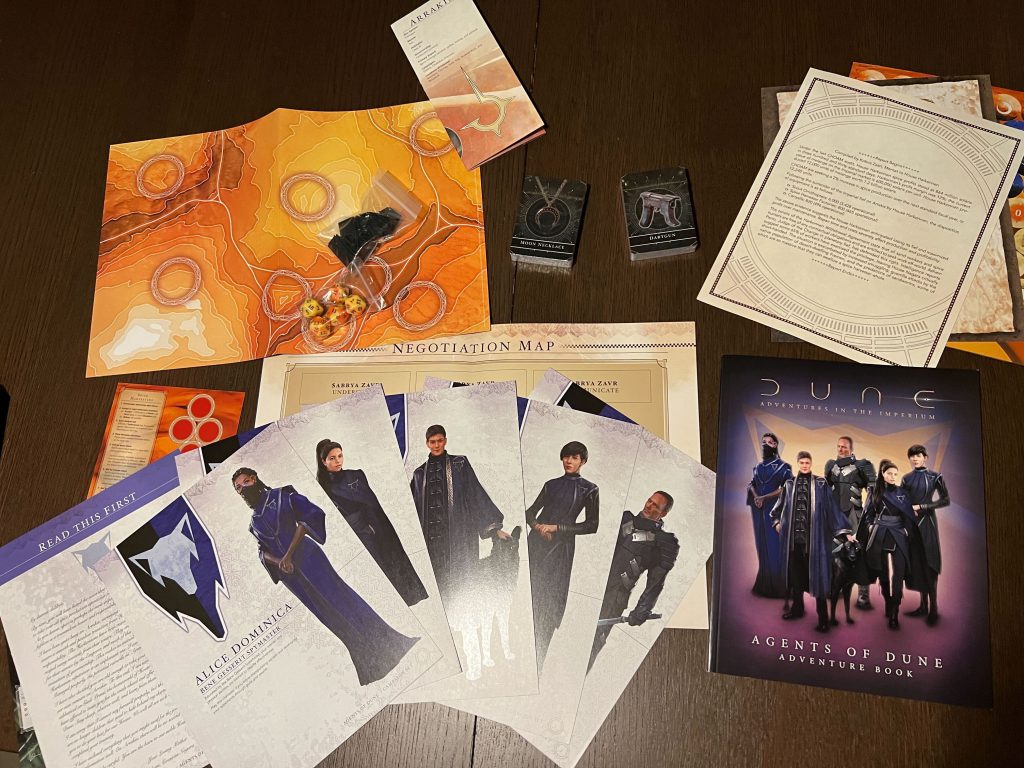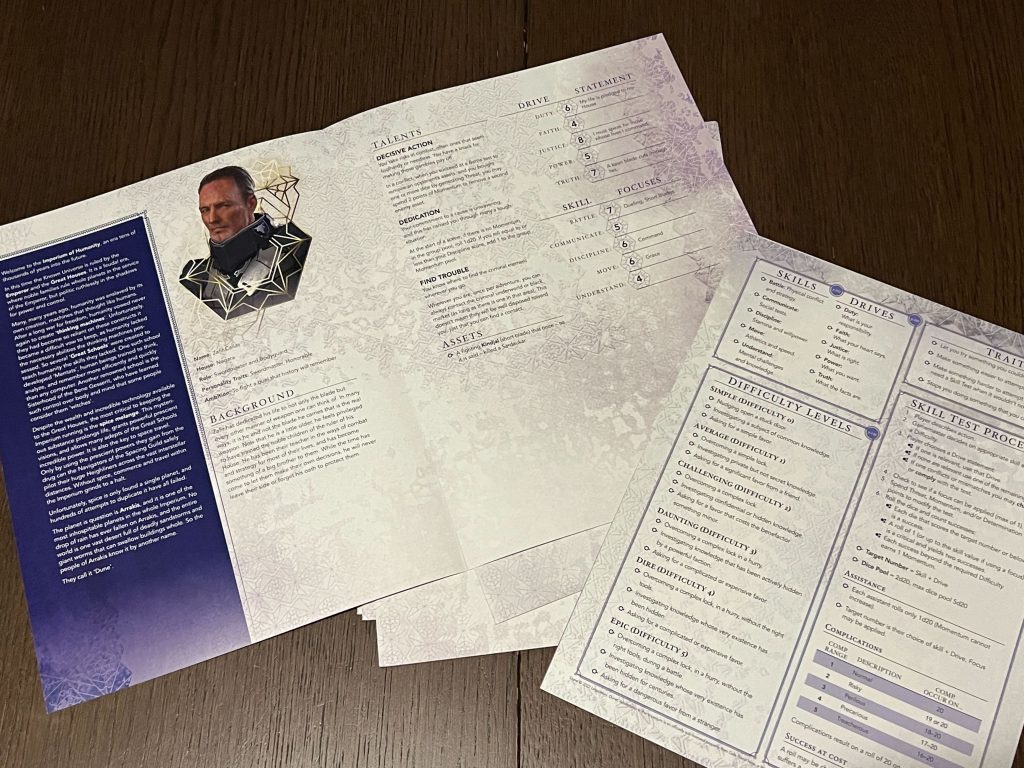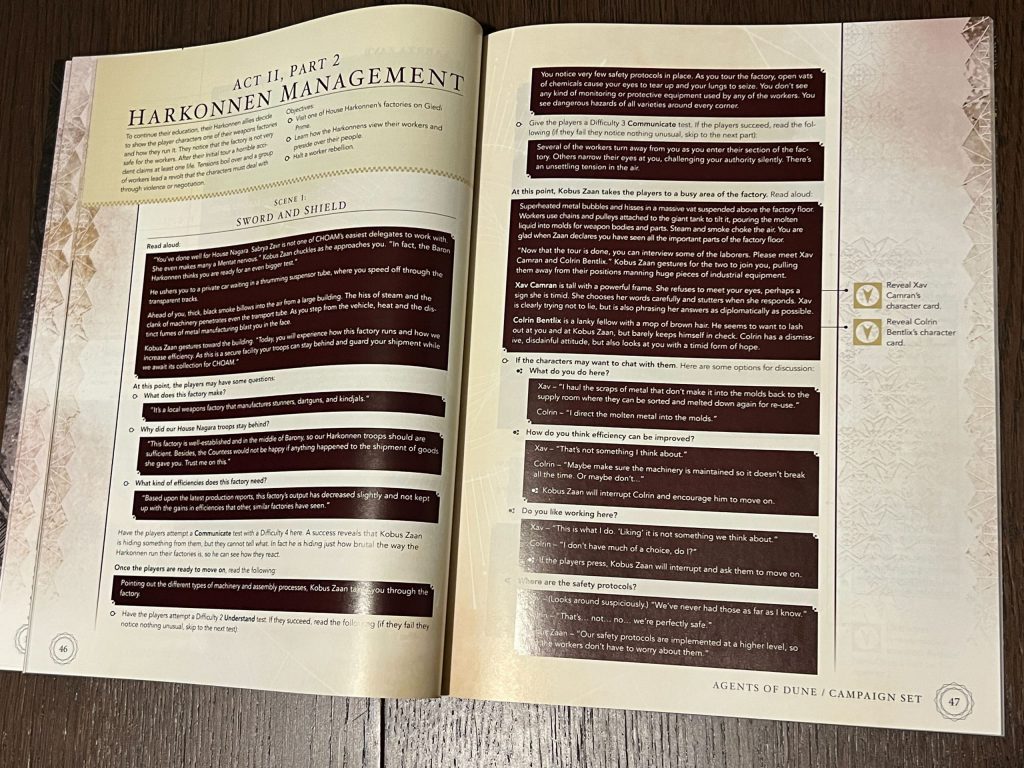Agents of Dune is the ultimate onboarding tool for Dune: Adventures in the Imperium
It’s not uncommon for companies to try and take existing universes and spin them out into role playing games, with franchises like Xena, Dr Who and Discworld already having tRPGs it was just a matter of time before Dune made the jump, with Dune: Adventures in the Imperium launching a few years back; however, what was perhaps unexpected was this year’s Agents of Dune, a bumper campaign that slots players directly into the epic, replacing House Atredies with one led by the players.
Dune: Adventures in the Imperium launched to critical acclaim back in 2021. It was celebrated for carefully balancing a fresh deployment of the 2D20 system with the minutia-heavy outline of Frank Herbert (et al)’s extensive Dune setting, and it’s often discussed because of how it managed to fuse into something that diverges from a lot of traditional RPG play structures, while also appeasing hyper-fans of the source material. I only knew surface-level stuff about the Dune setting before reading the core book, but long after reading through its 70 pages dedicated to the worlds, ancient factions, political structure and 11-thousand-year history, the stuff is still rattling around in my head. Ironically, I didn’t need to intricately pore over the core book — although information on the setting is useful — to review Agents of Dune, because everything you need is already included in the box with the standalone campaign, and it does a pretty great job of explaining systems and processes as they arise.

In fact, if you’ve played any sort of pen & paper RPG and you’re debating whether you should pick up Agents of Dune alone or with the core book, this review probably isn’t going to help you decide. It’s my belief that, in short, the core book (Adventurers in the Imperium) is great if you have a boisterous group who like to play outside of the rules, or if you want to go through the setting outside of this campaign; However, if you’re a gang who are likely to try and play within the bounds of the setting (which, as fans of the property will know, does feature a few ‘yeah, that’s it, you’re dead now’ things, like atomics, or lasguns firing at shields) or want to run a ‘what if?’ scenario for the film then the campaign box is all you need.
The Adventures in the Imperium book covers creating your house, the characters you’ll play within it — and their focuses, archtypes, skills, talents, drives and assets. It covers skill tests, momentum, complications, threat and contests. These mechanics are the factors that define your characters rather than stats and attributes, while threats and momentum are like the difficulty modifiers (and Hero Points, or equivalent) of other RPGs. It covers its conflict systems in detail, which is a clever system that works to almost any scale due to the simple, malleable design of the threats, momentum and complication systems, and it gives you some handy tips for keeping players within roleplay. Finally, it features a 12-page campaign, 60 pages on allies and adversaries, a breakdown of how assets work and a nice little appendix section to work.
The thing is, where Adventures in the Imperium promises to set you loose in the setting (where many players will inevitably want to ‘what if’ the events of the main book), Agents of Dune actually does it.

Agents of Dune
Agents of Dune, then, is a really streamlined version of the Adventures in the Imperium setting, it slots the game master into more of a narrator role by providing them with a large cluster of scenes that lead the player’s now Major House, the House Nagara, through the events that follow the Harkonnen surrendering Arakis to a new family. Rather than the Atredies family taking the helm (surely this means that Paul never finds he is Muad’Dib?) it’s yourselves, and without the malicious intent that the Harkonnen held toward House Atredies quite so present, there’s not quite the same amount of imminent death on the horizon.
In fact, while your house head is on Arrakis, you are training under the Harkonnen.
It’s definitely not going to be easy taking over operations though; about 65% of the workers have left the planet, around 40% of the planetary Ornithopters, Factories and Carryalls are out of operation and CHOAM are expecting you to increase production by about 2%. Basically, there’s a lot of work ahead, and while the Harkonnen have offered to help in some capacity, and are training you to take over, it’s hard to trust them considering the situation they’ve left the planet in.

Included inside the box are the contents & briefing doc, five pre-made character folios, the three-act adventure booklet, character cards, asset cards, trait card, a couple of handout letters that set the scene, a briefing booklet on the planet, three trackers and associated trackers and five D20s. This is everything that you’ll need to run the campaign, although you also get a digital download code for the core rulebook if you want to look further into the setting and rules (if you have a group that is not used to the ‘scene’ structure).
In fact, everything beyond the campaign tracker is a massive visual boon and a combination of really well-thought-out aids to storytelling and immersion in the campaign. When you see, experience or hear about really dedicated GMs or DMs running campaigns the subject of extra materials and visual elements like this do come up, and so to have those included in the box gives the whole thing an air of depth that most campaign books don’t go for.

The campaign itself is full of as many twists and turns as you might expect from a three-act piece set in the political powderkeg of Arrakis. Act One serves as training as the player characters must resolve a string of situations, gradually meeting more of the Harkonnen house. Act Two kicks off after a failed assassination, as they delve into politics before it concludes with a major twist, while Act Three thrusts them into oversight of Arrakis and, ultimately, the peeling back of a conspiracy that they have multiple ways out of. Survival, both as a House and a player, is intended to always be at the forefront of the player’s mind, but there are several points where your aptitude at decision and resource management come through, which — partnered with all of the cool extras — stops the whole thing from feeling as on-the-rails as it is.
Agents of Dune actually feels like the ideal gateway into the Dune: Adventures in the Imperium setting. It feels as though somebody was paid to create an ultimate guide to playing within the universe, a hands-held first adventure to warm up new players to the idea of taking on a campaign in the setting. It’s a masterclass in staggered introduction of mechanics, and spits players out at the end with their House’s saga wrapped and the perfect opportunity for the GM to crack out the core book and spin up a new campaign.

In fact, I’d say that this is almost the definitive way to do it. This way you minimize the risk of players breaking taboos like heading out without Still Suits, breaking Amtal, drawing a Crysknife but not shedding blood, or ruining everything by firing lasguns at shields. Dune’s medieval feudalism, forced lo-tech combat and strict political rules can be incredibly daunting to those who know the depth of the universe and feel they lack knowledge; Agents of Dune is a phenomenal on-ramp.
Agents of Dune is available now from Modiphius’ website and other retailers.
Comments are closed.